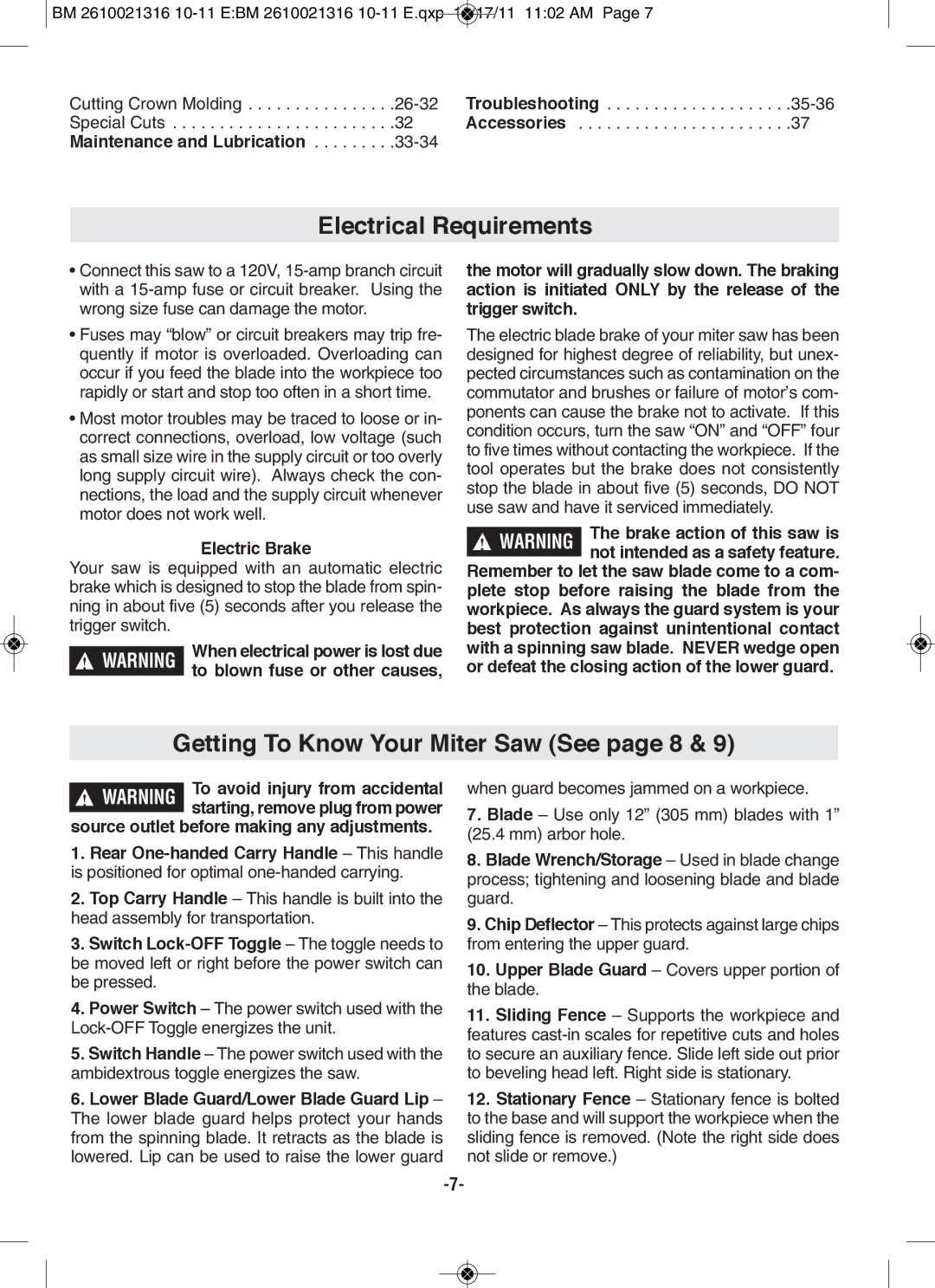
![]() BM 2610021316
BM 2610021316
Cutting Crown Molding | Troubleshooting | ||
Special Cuts | .32 | Accessories | 37 |
Maintenance and lubrication |
|
|
Electrical Requirements
•Connect this saw to a 120V,
•Fuses may “blow” or circuit breakers may trip fre- quently if motor is overloaded. Overloading can occur if you feed the blade into the workpiece too rapidly or start and stop too often in a short time.
•Most motor troubles may be traced to loose or in- correct connections, overload, low voltage (such as small size wire in the supply circuit or too overly long supply circuit wire). Always check the con- nections, the load and the supply circuit whenever motor does not work well.
Electric Brake
Your saw is equipped with an automatic electric brake which is designed to stop the blade from spin- ning in about five (5) seconds after you release the trigger switch.
| When electrical power is lost due |
! WARNING | |
| to blown fuse or other causes, |
|
the motor will gradually slow down. The braking action is initiated ONlY by the release of the trigger switch.
The electric blade brake of your miter saw has been designed for highest degree of reliability, but unex- pected circumstances such as contamination on the commutator and brushes or failure of motor’s com- ponents can cause the brake not to activate. If this condition occurs, turn the saw “ON” and “OFF” four to five times without contacting the workpiece. If the tool operates but the brake does not consistently stop the blade in about five (5) seconds, DO NOT use saw and have it serviced immediately.
The brake action of this saw is not intended as a safety feature.
Remember to let the saw blade come to a com- plete stop before raising the blade from the workpiece. As always the guard system is your best protection against unintentional contact with a spinning saw blade. NEVER wedge open or defeat the closing action of the lower guard.
Getting To Know Your Miter Saw (See page 8 & 9)
!WARNING To avoid injury from accidental starting, remove plug from power
source outlet before making any adjustments.
1.Rear
2.Top Carry Handle – This handle is built into the head assembly for transportation.
3.Switch
4.power Switch – The power switch used with the
5.Switch Handle – The power switch used with the ambidextrous toggle energizes the saw.
6.lower Blade Guard/lower Blade Guard lip –
The lower blade guard helps protect your hands from the spinning blade. It retracts as the blade is lowered. Lip can be used to raise the lower guard
when guard becomes jammed on a workpiece.
7.Blade – Use only 12” (305 mm) blades with 1” (25.4 mm) arbor hole.
8.Blade Wrench/Storage – Used in blade change process; tightening and loosening blade and blade guard.
9.Chip Deflector – This protects against large chips from entering the upper guard.
10.Upper Blade Guard – Covers upper portion of the blade.
11.Sliding fence – Supports the workpiece and features
12.Stationary fence – Stationary fence is bolted to the base and will support the workpiece when the sliding fence is removed. (Note the right side does not slide or remove.)
